Unless you live in a cave, you know that tonight in Southeast Portland, City Commissioner Sam Adams will announce his candidacy for mayor (5:30 at Roots Brewing in SE Portland).
But that’s not why I met up with him for an interview on Tuesday.
Surprisingly, even though we’ve seen each other a countless meetings and events over the past two years, we’ve never spoken for more than a few sentences here and there.
It was good to finally sit down and hear what he had to say about how bikes figure into the future of our city.
In the interview below, we touch on a bunch of topics; from an upcoming ballot measure that will include over $24 million for bike boulevards to a progress report on his plans for a bike-sharing system, and even a mention of Portland’s first separated bike lane (aka cycle track).
Read on for the scoop on these and other topics…
I have a photo of you from the 2006 Bridge Pedal when you were passing out “Sam for Platinum” buttons. What’s the latest on that effort?
The Platinum Effort has been combined with the update to the Bike Master Plan. There was an ongoing effort to put in the application for Gold Bicycle Friendly Community status; then there was my desire to renew the Bike Master Plan, so we combined them into the Platinum Bike Master Plan. We’ve also integrated the [Transportation] Options Division with that (although it’s a separate effort) and we’ve worked to better integrate the operational issues, like maintenance, that make bike facilities…Roger [Geller, the City Bike Coordinator] is the core of the effort, but we’ve also created a large group of folks who are working on this.
So maybe we should just send in the new Bike Master Plan as our Platinum application?
Well that’s kind of my thinking…they should be one in the same effort.
You mentioned the maintenance bureau. I realize they’re not always as gung-ho about bike projects as other folks at PDOT. How are they being brought into the effort?
It’s the separation that exists, and has existed, between policy and operations within PDOT, until recently in almost every transportation issue. Whether it’s ped or bike or freight or even automobiles. So, what I’ve done is eliminated the bureaus.
PDOT used to be the Office of Transportation then four bureaus underneath that have now been eliminated. Now we have one Bureau of Transportation and we have groups within that. As of two months ago, they are no longer standalone bureaus. It’s now more integrated and I meet every week with all the group leaders and the key policy people and we go through all the issues.
I’m meeting with the bike people and the maintenance and operations people in the same room every week, along with the Director [of PDOT, Sue Keil]. I take them out on walk-alongs. I’m constantly trying to break down those silos that have existed within the bureau. And then break down the gap that has existed with pieces of the bureau and the community.
Those walk-alongs sound like you’re focusing on refinements to the existing network. One issue that comes up frequently is that spending and additions to the bikeway mileage are flat. Is PDOT purposely focusing more on refinements rather than adding new bikeway miles? Or is it a matter of funding?
“I want biking, transit, and walking to be the preferred transportation choice for all Portlanders.”
My view, and we’re translating it in the Bike Master Plan, is that investments in bikes are a great transportation deal. We get a huge return for a modest amount of money. We have 1.5% of the total Capital spending for the next five years and we get citywide a 5.4% utilization. That’s a great deal. I don’t get that kind of ROI [return on investment] on any other mode.
So, part of it has been to do the research and convince the bureaucracy that this is a good investment, and that it’s worthy of additional investment; and that means upgrading the existing system for convenience and safety.
What we need is a lot more investment. I think the results we’re seeing are worthy of much more investment in bikes and expansion of bike infrastructure. I’m excited to have on the drawing boards the $24 million going into a 110 mile expansion of bike boulevards [a reference to his Safe and Sounds Streets campaign addressed later in the interview]. I think we’re going to see a doubling in ridership in a lot of areas of the city.
My hope is that we can get upwards of past 20% in the central business district because it is the safest, most reliable, fastest way to get between two places in a lot of the city. And the opportunities for the bike boulevards are that they meet the needs of motorists and bicyclists. We’ve learned that through the focus groups and polling as part of our Platinum Bike Master Plan work.
It’s really strange; as part of Safe and Sounds Streets survey we gave people a chance to rank 15 items for spending priority and bike lanes fought for last place with freight mobility. But when we did the focus groups earlier and we asked people, what do you like most about Portland, they said light rail and bikes.
So being able to satisfy those people who are afraid of hitting bikes — which is what we uncovered — and non-bikers who would use it as a mode more if they had choices other than just the busy streets, is how we decided on the bike boulevard expansion.
In addition, in the central business district I’d like to see more separated bike lanes. We’re doing our first one from the Burnside Bridge to Broadway as part of the Couplet project [the Burnside-Couch plan].
How did you arrive at a separated path (a.k.a. a “cycle-track”) as a good solution? Was it your trips to Europe? Demand? Did you want it to be a centerpiece?
First, it’s a good investment in change. Because every time we do something to expand the system or make it safer (either perceived or actual) we get increased usage.
The other thing is that it reinforces the reality that the right-of-way is multi-modal. It has a restorative aspect to the right-of-way that just right-of-way for cars doesn’t necessarily provide.
It also reinforces what people say they think is special about Portland; and one of the key things is our bike culture.
Building our first cycle-track is a big step toward more innovation in our bikeway, something many of us have been clamoring to see more of. What other innovative things are down the road?
We’ve made good progress on our rent-a-bike proposals [plans for a bike-sharing system in downtown Portland]; they’re due back on October 17th. We’ve already had inquiries and conversations from five companies, all international, so far. We’re real excited about that because I think a rental bike program makes biking possible for those people that are sort of land-locked, or locked out. What Lyon [France] experiences, is that people might have to ride over the mountain to get to downtown, but once they’re there, the percentage of people that use the bikes is huge.
Separated bike lanes and the bike-sharing program would be steps toward making Portland a world-class bike city. I know you’ve visited Amsterdam, and other bike cities, but we’re clearly not at that level yet. What will “world class bike city” mean in the Portland context?
I want biking, transit, and walking to be the preferred transportation choice for all Portlanders. That doesn’t mean it will work for them for every trip, but it is what they would prefer to do. And so that requires that we expand the system and make it higher quality both in safety and convenience.
It’s also about integration. We’re not doing a good job of integrating bike usage and transit. We’re not. The extent of it is, bring your bike on if you can, until you don’t have any more room. Clearly the BikeStation concept, the rent-a-bike program must be worked on…as you know in Europe they have all these stations full of bikes because they have a cheap bike that they use from work to the station and they have another cheap bike from the station to work.
One of my concerns with the park-and-ride model (that works so well in Europe) is that we don’t have the level of safety in our bike network to get people to the transit centers to begin with. Same with the bike-sharing program. Novice riders must feel safe downtown or it doesn’t matter how good of a free-bike system we have…
I agree and I think that’s where the separated lanes/cycle-tracks are key. Downtown, where traffic is so concentrated…that’s a layer of protection that, if we can provide, more people will use it.
Portland, what I see as the American context of a world-class bike city, is a lot like Amsterdam. But I think we need to acknowledge that we don’t have the concentration of rail transit that they do, so we have to figure out the BikeStation and rent-a-bike type programs.
There has been an expectation up until this point that you can take your bike on transit. I’d frankly like to figure out a way to continue that. Whether it’s a bike railcar in the back, a bike wagon, or whatever.
One of the things I’m pushing for rail is to develop it into local and express lines. And the local line would have a bike-car. As we’re thinking through the transportation needs of the future, bikes are an integral part of it, not something we think about at the end. And even during the last 2 years we had the issue of getting bike lanes on the streets in the South Waterfront, and getting the bike lane extended up the transit mall… It’s moving the culture from, ‘oh, it’s nice if we can do it we can’ to thinking about bikes at the outset.
Given all the momentum for bikes in this town, what sort of rate-of-change do you foresee from where we are now, to where we want to be?
I think we’re ready for a leap. That’s why I feel that over the past two-and-a-half years I’ve been Transportation Commissioner we’ve dug in and figured out what it would take to take the leap.
I feel the bike boulevard program and the template we’re coming up with for the Platinum Bike Master Plan for the central business district is a huge leap forward; and a smart investment. It’s no longer because it’s [investing in bikes] just the right thing to do, it’s because it makes sense from a transportation point of view. And whether you ever get on a bike or not, you benefit from have a strong, a complete, and safe bike network in the city; because it’s less congestion, less pollution, lower health care costs for non bike riders.
You mentioned the streetcar network. The streetcar plan is moving forward with similar momentum to the Bike Master Plan efforts. I have concerns about track safety and sharing limited right-of-way with streetcars. Is there any way to make the tracks safer? And what can we do to better integrate those two efforts?
I think the low point in that relationship was the South Waterfront streetcar/bike lane situation. The bike lane was sort of put in at the end and the streetcar folks had really not been talking to the bike folks: that was a low point. Part of what we’re doing with the citywide streetcar plan is making Roger [Geller, PDOT bike coordinator] and others are part of that effort.
We also need to coordinate streetcar with the [bike] boulevards. I want to give to the bikers what the streetcar has, and that is a street; a convenient street that gets them to and from where they want to go, where the bike is the priority, not the car.
The bike boulevards and the streetcar system have to complement each other.
“Whether you ever get on a bike or not, you benefit from have a strong, a complete, and safe bike network in the city.”
As for how can we make the tracks safer; it’s a problem. I can tell you my lowest preference is to have bikes and streetcars on the same route. My first preference is streetcars go on arterials that serve the fastest traffic, and then the bike boulevards are the next streets over.
Speaking of bike boulevards. Let’s talk about Flanders. Your plan for Burnside-Couch has on-street parking, no bike lanes at all, and you’re encouraging folks to ride several blocks to Flanders instead. How do you justify that decision with your goals for making us a world-class bike city?
There are right-of-ways in the city where it’s just really hard to make everything work. The Flanders street agreement [referring to a compromise between the BTA and others that gave up bike lanes on Burnside-Couch in exchange for the promise of a bike boulevard on Flanders] I definitely could have undone but it was an agreement made before I got involved with the project. We did look at the possibility of putting bike lanes on Burnside, but to get the parking, and the bike lanes, and the travel lanes, it just didn’t work out.
So on-street parking was something you just had to do?
Yes. We had to do it to make pedestrians feel safe, with the amount of traffic it gets, and to stimulate the kind of street-level storefront activity we want. My first preference would be to have them on Burnside. Our ridership between NW and downtown on bikes is really anemic, so we’ve got to do something.
We’re actually doing quite well with the bridge idea over Flanders [referring to progress on efforts to place the old Sauvie Island bridge across I-405 at Flanders].
But yes, asking people to go over two blocks to Flanders is an imposition, but remember, this is a city where bikes can go anywhere, and going downhill on bikes on Burnside is going to be safe because it’s timed so you know where the cars are and it will be pulsed [referring to the traffic signals].
I think for people going uphill though, giving them Flanders is fine, since I just couldn’t come up with the right of way. So sometimes we can push and succeed and sometimes we’ve got to come up with other alternatives. That’s the honest answer, we push as hard as we can.
Speaking of pushing, we had a situation earlier this year where the Mayor somehow thought the Bike Master Plan didn’t deserve funding. It made me wonder whether the bike community was doing all it could to be effective in City Hall. What do you think we could be doing better to help move bicycling forward in Portland?
First off, I think the bike advocates are doing a terrific job. The numbers speak for themselves, the partnership between bike advocates and organizations and the city is very strong. I think it’s stronger now than ever. Having said that, nothing’s perfect.
When I became Transportation Commissioner I was surprised PDOT didn’t break up their expenditures by mode. So I asked them to analyze the budget by mode and, lo and behold, we found 1.5% of our capital work goes to bikes and that was an expansive definition. All this other money was going to cars and 16% was going to peds. It was clear to me that PDOT was under-spending on bikes, and so the numbers we’re getting [in ridership] for relatively flat spending from PDOT over the past five years is pretty remarkable. That says to me that we’re ready for a big investment.
So how does the bike community help make sure we realize that investment?
When I say we’re ready to make the leap I don’t just mean me. I’m grabbing the bike advocates and jumping forward. You know, a $24 million expenditure on bikes is more than the city has ever done, combined. That’s a huge leap, but I think we’re ready for it.
So what can we (the bike community and advocacy groups) do?
Build relations. Build relationships with what you consider to be unlikely suspects. There are a lot of downtown movers and shakers that are big bike advocates, but who had until recently, never been approached. People like Mark Edlen [of Gerding Edlen Development] ride their bike every week. You need to build a more expansive coalition.
The bike advocacy community really has to move out and see the potential rider as their friend. All the credit for getting to where we are right now is to that hardy bike rider who has suffered through the crappy system and the lack of safety but now needs to say, ‘Hey, it’s OK, you’re one of me if you only ride your bike once a week, you’re one of me if you only ride recreationally; you’re one of me.’ If we do that and expand the coalition and expand who we recognize as a friend, we can get this done.
So let’s talk about your Safe and Sound Streets campaign. How do bikes figure into it?
What’s on the drawing board right now, subject to working with a stakeholder committee and public feedback, is an investment of $24 million to build 110 miles of bike boulevards. A lot of that money goes to signalization, so it’s even beyond what you can imagine right now. Right now we’ve got bike boulevards that hit 39th and in some ways they’re more dangerous than crossing at the busy street because there’s no signal at all! So a lot of this is about signalizing the bike boulevards. So when you hit the busy streets, hopefully you trip the signal so you never stop. And we know from our focus groups on the Bike Master Plan that we’ll get a lot more ridership that way.
Also, we’ll have $2 million a year for sidewalks and, as we do sidewalks, we’ll also be putting in bike lanes. This is especially important for the 46% of the busiest streets in Southwest Portland and the 28% of busiest streets in East Portland that have no sidewalks. So you’d be seeing a significant investment in bike boulevards, but also an investment in bike lanes.
So how would it work? Would the $24 be available instantly? When could we see these new bike boulevards getting built?
We’re going to do ‘pay as you go’ for all the projects except the bike boulevards. I would like to implement those in three years. Everything else will take ten [years] or more.
What is the timeline from here?
This January, the City Council and the County Board will be considering putting something on the ballot in May ‘08. It’s basically going to be a ballot measure, and when I say I’ll be testing the resolve of the bike community, what I’m really talking about is; we’re going to have a bond measure in May of 08 that will include the bike improvements.
So that’s an opportunity for the community to speak up?
Yes. I’m putting us to the test. I think we’re ready. The polling showed that bike boulevards were the third most popular expenditure overall. What Portlanders were basically telling us is that we don’t want more bike lanes…we love bikes, but we want them on the quiet streets. And I just want to be clear, we’re not going to deemphasize our bike lane program. This would be added to that.
________
Thanks to Sam for taking time to chat. In a few minutes, he’ll be publicly announcing his bid to be the next mayor of Portland. Regardless of what happens with that, I’m sure we’ll be hearing a lot more from him in the months and years to come.



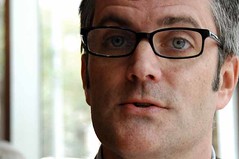

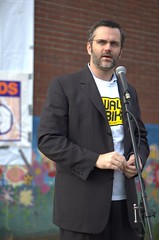
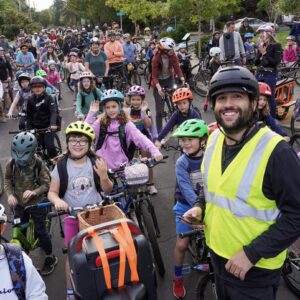
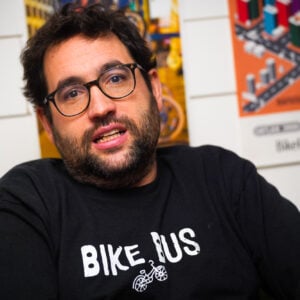
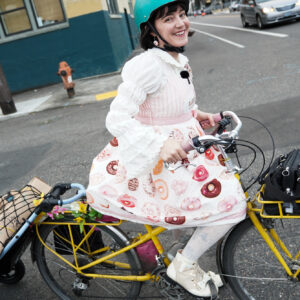

Thanks for reading.
BikePortland has served this community with independent community journalism since 2005. We rely on subscriptions from readers like you to survive. Your financial support is vital in keeping this valuable resource alive and well.
Please subscribe today to strengthen and expand our work.
Ok I understand and support the need for bike boulevards, you have my vote there Sam. But the bike rental program? Who exactly is this going to serve? I suspect that the vast majority of people can afford a bike of their own. And most of them I assume prefer a bike that has been adjusted to fit their frame. Furthermore, let\’s not forget the free yellow bike program of the past and how that flopped. Do we really need to spend money one bike rentals or can it be put to better use someplace else?
Sam for Mayor.
Great questions, Jonathan. I can\’t wait to see Sam in the mayor\’s seat, along with Chris Smith filling his current transportation bureau role.
I have to agree with bikerbob (post 1). Lets not throw $ at a pie in the sky.
That said –
am so stoked to have Sam for Mayor
\”Lets not throw $ at a pie in the sky.\”
Quincy and bikerbob.. .. Do you both realize that what he\’s talking about is a bike-sharing system? Like the one that is having phenomenal success in Paris and being seriously considered in other cities like San Francisco and NYC? This is far from a pie in the sky.
Impressive interviewing. I love you.
This summer I went back to Brescia, my home town in Italy and I very surprise to see that in the last few years they were successfull on making the whole downtown pedestrian and bike only, the only cars around were for service to shops and residents. At the parking structure they had a free bike you could get by leaving you ID. The bike traffic was amazing, from the old lady to the guy in suit. It would be great if downtown Portland could be more bike friendly, as it is and with all the construction going on it is very dangerous even for experienced cyclist.
Thanks for the interview Jonathan, first class as usual.
Ciao
Paolo
\”Lets not throw $ at a pie in the sky.\”
If we are talking about a bike sharing program that emulates flexcar, I could see how that might work, especially if there are enough participants to offset the costs maintenance etc). I just remember all too well yellow bikes at the bottom of the Willamette. I WANT ideas like this too work. just too cynical i guess.
Great interview Jonathan
I was in Vienna this year and made use of their bike rental progam. It was free for an hour and then a very low rental fee after that. There were numerous places you could return the bike to all over the city. As a tourist it was just what I needed. How great would it be for people visiting Portland, partly because of its \”green factor\”, to be getting off a plane and being able to rent a bike to explore our fair town with. Maybe get some bakfiets out there in the rentals as well for baggage!
I could also see non-tourists using it for a quick errand run…maybe you don\’t want to lose your parking space, or you know it would be faster to ride a bike to where you are going than drive, but you did not ride your bike to work.
This will not fail like the yellow bike program, as it is not free. You need some sort of debit card or credit card to gain access to a bike.
I know that most people reading this site have their own bikes, maybe even 7 bikes, but a lot of people do not, and maybe this program would encourage those to get on a bike.
p.s. Sam Adams for Mayor
Bike advocacy in Portland really is amazing. We have BTA and SHIFT and PDOT working for Portland, but what ties it all together, keeps me connected, informed and involved is bikeportland.org. This site is the most effective grassroots effort I can imagine. And the only advertising I have ever seen is pictures of Jonathan\’s \’license plate\’ at Cycle Oregon.
Sam Adams for Mayor absolutely! And thanks Jonathan for keeping us involved.
Sam could actually be mayor and still retain the transportation bureau in his portfolio.
For me the big message from Sam to bikers: Make Friends.
We need to be the big tent that invites people in. We can\’t self righteously be exclusive. Pulling this off means getting to know and learning to respect every flavor of biker and then going a step further and reaching out to the non-biker.
All the bickering on BikePortland.org regarding how many gears, or what style of clothes, or helmets on or off needs to take a breather and larger more collective issues need to emerge.
At another level, the growing Portland bike industry and bike friendly Portland businesses need to do a similar networking. The bike lobby and associated groups need to refine a \”We\’re all in this together\” message and start getting it out there.
And I guess we need to work on getting a new mayor and council elected. This part actually seems fun.
Darren
Darren, you are right on!!
The bike sharing program was just profiled in the San Francisco Chronicle. The link is above. It is hardly pie in the sky, as it\’s been quite successful in Paris and other European cities. They coined this the \’third gen\’ of bike sharing. Take a look, the article says more than I can.
If we really want to take a leap and create more seperated bike lanes or cycle-tracks, lets replace some on-street parking with bike lanes. That will make for a safer cycling experience and de-incentivize driving. Many streets have parking on both sides of the street (essentially 4 lanes for cars when you figure the 2 driving lanes in) and nothing for bicycles. Why not start with Alberta street where we have a large number of cyclists on a street that is uncomfortably narrow to ride on because of the parking on both sides of the street. Alberta is a neighborhood bold enough to give this a try…i.e. I think the business along Alberta would support it.
I think bike sharing is well worth the effort and money spent. And it won\’t take much money since it will be contracted out to a company that will (hopefully) make a profit on it.
If all it does it get some drivers to take a bike to lunch instead of their car that would be great, but I believe it will do much more than that.
A lot of people will try bicycling and find out it is a lot quicker, easier and safer than they thought. Many of those people will eventually become bike commuters. This is a great way to bring new people into the biking community.
Great interview. The future looks bright.
Some facts on European bike-sharing programs:
\”In Lyon, according to deputy mayor Touraine, the city\’s 3,000 rental bikes have logged about 10 million miles since the program started in May 2005, saving an estimated 3,000 tons of carbon dioxide from being spewed into the air. Overall, vehicle traffic in the city is down 4 percent, he said, and bicycle use has tripled, not just on account of Cyclocity, but also because the program has prompted a boom in private bicycle use and sales.\” (source)
\”Lyon experienced a 400-500% increase in bike model share in 2 1/2 years with Velo\’v and Barcelona experienced a 100% increase in three months with Bicing.\” (source)
\”Paris\’s Velib\’ bike-sharing program has reached an important milestone after just three weeks since its launch – 1,000,000 trips have been made on the utilitarian public bicycles.
Paris\’s deputy mayor for transport, Denis Baupin, states that an average of 6 trips are made on each bike every day. With 10,000 bikes at the present time, it\’s no wonder that so many trips by bike have been made. Baupin goes on to say, \”Once all the stations are up and running, Velib will be carrying as many people as the Paris tramway.\” (source)
To be honest, I like parked cars. Sure, sometimes they open their doors into our paths but, for the most part, I find that they really slow down traffic and buffer the sidewalk nicely.
I\’m down with eliminating parking, but let\’s not forget how useful those hunks of steel are when they\’re not moving.
After visiting Paris in September, I understand that the bike-sharing program, Velib, targets residents that otherwise drive and not local bicyclists or tourists (you need a European credit card to use a bike.) I was surprised by this but it makes sense that tourists may not be the best caretakers of the bikes, and in Paris at least, the tourists are often already not driving.
I have no data but my active observations showed that roughly half the bikes being ridden in central Paris were Velib bikes. It was amazing to see.
I have confident thoughts something similar could work here.
Here\’s a pic I took of a Velib bike if interested: http://www.flickr.com/photos/40396973@N00/1474095655/
I don\’t think that Paris is designing the program to keep tourists out, but they also aren\’t going out of their way to make it work. The European credit card thing is just sort of reality. That said, a lot of the programs I\’ve seen have no quick sign-up process. For example, I was in Cordoba, Spain, and they had a good loaner bike system (photo here), but it would have taken about a week for the application to go through.m
Something needs to be done about people driving downtown to work. One person per car. Ridiculous. I personally know a few that could easily take the bus but won\’t. These selfish people should pay for the pollution and congestion they cause. I know the PABA would have a hissy fit, but we need a toll for pinheads who drive downtown every day.
Sam needs a decent razor and hair stylist.